|
|
|
|
Geometry and use
of trigonometry
|
|
|
|
Applications
of trigonometry in solid geometry
|
|
Oblique prism
|
|
As an example of an oblique prism consider a parallelepiped whose lengths of the base edges and the lateral
edges sharing a common vertex are,
a,
b and
c. Edges,
a and
b of bases, are perpendicular to each other, while the lateral edge
c, forms the angle
a with each of them, see
the figure below.
|
|
Determine the volume, the surface area of the
parallelepiped and the angle lateral edge to base.
|
| The volume
V =
B
· h =
a
· b
· h.
|
|
The altitude of the parallelepiped is the intersection line of
the planes, A1EN
and A1FN which are perpendicular to the base
edges, a and
b and
thus to the plane of base.
|
|
Created
triangles A1AE and A1AF
are congruent as they share the hypotenuse and both have the same angle
a.
|
|
Thus,
A1E =
A1F
and therefore triangles, A1EN
|
|
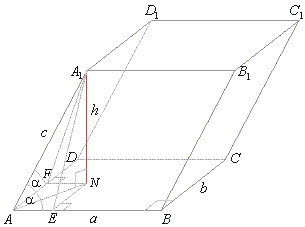 |
|
|
and A1FN
are congruent, so that EN =
FN. AN is the bisector of the right angle
DAB.
|
 |
|
As by hypothesis, the base edges at the vertex
A
are perpendicular and the lateral edge c
forms equal
angles
a with the base edges, then must be
a > 45°, or
2a >
90°, and therefore, -
cos2a >
0. |
|
Note that, if we follow changes (decrease) of the angle
a
while the height h tends to zero, finally, the end points
A1 and
N will coincide, and the lateral edge
c equals its
orthogonal projection AN (bisector of the right angle,
2a =
90°).
|
| So the volume of the parallelepiped |
 |
|
| Surface area
S
= 2B + Slat. = 2ab + 2ac
· sina
+ 2bc
· sina
= 2
· [ab + c
· (a + b)
· sina].
|
|
Inclination of the lateral edge to base,
|
 |
|
|
|
Oblique pyramid
|
|
As an example we consider the pyramid with square base. Two opposite faces are isosceles triangles one of
which forms with the base interior angle
b, and the other forms with the plane of the base an exterior angle
a.
The height of the pyramid is
h.
|
|
Determine the volume of the pyramid and angles that form two other lateral
faces with the plane of the base.
|
|
The plane
VFG
(F and
G are midpoints of sides of base) is
perpendicular to the plane of the base and passes through the
height h of the pyramid.
|
|
Since a
is an exterior angle of the triangle VFG, the foot
N of the altitude
h falls at the extension of the side
FG.
|
| The
volume of the pyramid |
 |
|
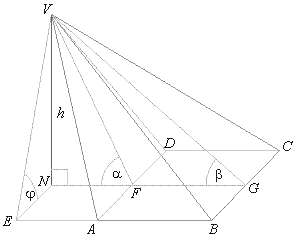 |
|
 |
|
The angle of inclination of the lateral sides
VAB
and VCD
to the base we determine from the triangle
VEN
which is perpendicular to the plane of base, and whose leg is parallel with the edge
AD of the base,
|
| thus
|
 |
|
|
Example:
Bases of a triangular prism are isosceles triangles,
ABC
and
A1B1C1, with equal sides
AB = AC
and two equal angles
a. The normal projection of the vertex of the upper base falls at the center of incircle of the radius
r
of the lower base. Through the base edge AC
and the vertex B1
laid is a plane
inclined to the lower base at angle
a. See
the figure below.
|
|
Determine the surface area of the pyramid
ABCB1
cut off from the prism and the volume of the prism.
|
|
|
|
|
Volume
and surface area of solids of revolution, Guldin’s rules
|
|
For example, a regular hexagon of the side
a rotates around an axe which passes through one of its sides, determine the
surface area and the volume of generated solid of revolution.
|
|
The surface area equals to the lateral surface of
a cylinder and lateral surfaces of two conical frustums, and lateral surfaces of two conics.
Therefore,
|
|
|
|
The same result can be obtained applying
Guldin’s rules that states,
|
|
1) Surface area of a solid generated by rotation of a plane curve (a geometric figure) around an axe, which lies in the same plane but which do not intersect, equals to the product of the lengths of the curve (the figure’s perimeter) and the perimeter of the circle described by the centroid of the curve
|
| (the centroid of the
figure) therefore,
S =
P
· PG = P
· 2p
· rG |
|
Thus, applied to the preceding
example, the centroid of the regular hexagon coincides with its center so, the perimeter of the circle described by the
centroid, |
 |
| and the perimeter of the regular hexagon
P = 6a, plugging into above formula gives
|
| S =
P
· 2p
· rG =
6a
· Ö3pa =
6Ö3p
· a2. |
|
2) Volume of a solid of revolution generated by the rotation of a figure around an axe which lies in the same
plane as the figure, but which do not intersect, is equal to the product of the area of the figure and the perimeter of the circle described by the centroid of the figure,
|
|
therefore,
V =
A
· PG = A
· 2p
· rG |
| Thus, for the volume of the solid of revolution from the preceding example
|
 |
|
|
|
Applications
of trigonometry in geodesy (or plane surveying)
|
|
In plane surveying of
geographical features, boundaries and areas are determined by the measurement
of points and lines of direction on the earth's surface. Obtained horizontal and vertical distances and angles are then processed using computations based on geometry and trigonometry.
|
|
For example, to determine distance
x between points,
C
and
D, which cannot be measured directly, measured is the distance
d
between accessible points A
and B
and angles
a1,
a2 and
b1,
b2,
as shown in the figure.
|
| In
D
ABC,
|
 |
and in
D
ABD,
|
|
|
|
|
|
Example:
A ground in form of a quadrilateral should be divided into two equal areas, see
the below figure. At what distance from the vertex
C
dividing line segment AE
intersects the side BC
if lengths of sides are,
b = 24 m,
c = 28 m and
d = 45 m, and angles
b = 57° and
d =
115°.
|
|
Solution: In
DACD,
e2 =
b2 + c2 - 2bc
· cosd,
e = 43.9 m,
|
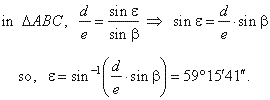 |
| since b
+ e
+ j =
180°,
j =
180° -
(e
+ b) =
63°44′19″.
|
|
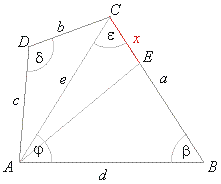 |
|
|
The area of the quadrilateral
ABCD as the sum of triangles
ACD
and
ABC,
|
 |
| The area of the triangle ABE
is required to be half of the area of the quadrilateral, thus
|
 |
|
|
|
Applications
of trigonometry in physics
|
|
Physical laws, as results and available experimental data we explain and write applying mathematics methods. We can show that trigonometry is often used in these
methods.
|
|
Take for example construction shown in
the below figure that is loaded by a force FG.
|
|
Determine the forces which act in the cable a
and b
that make the angle a
and b
with horizontal, respectively.
|
|
Resolve the resultant force FG
to its components Fa
and Fb
by using the parallelogram method on the vector diagram, thus in
DABC |
 |
|
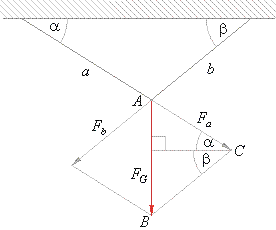 |
|
|
|
An example of using trigonometry in
optics
|
|
|
|
|
|
|
|
|
|
|
|
|
|
|
|
|
|
|
|
|
|
|
|
|
|
|
|
|
|
Contents
E
|
|
|
|
|

|
|
|
|
|
|
Copyright
© 2004 - 2020, Nabla Ltd. All rights reserved.
|
|
|